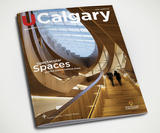
The Things That Worked
by Clem Martini, BFA’82
Illustration by Oliver Martini
In 2017, more than 747,000 Canadians were living with dementia; one in 11 Canadians over 65 lives with dementia. But this story is not about the devastating numbers — it’s about drama professor Clem Martini’s painful struggle to care for his mother
Listen to the article here
As my mother’s memory collapsed, we initiated something my mother and I called our “conversation book.”
The book held notes and drawings and was intended as a way for us to exchange stories back and forth. We had mixed success. By “mixed success,” I mean it didn’t work. By “didn’t work,” I mean, in comparison to other solutions, it was immensely successful.
I had hoped my mother would draw comfort from it between visits, that it would provide her with something to do. Mostly, she forgot about it until I arrived to remind her, then she would labour to draw together a few thoughts, and hastily put it aside. It proved to be more a chore than a comfort, and nothing was ever a replacement for my actual presence, which she never recalled, even when it was recorded in the book — even if it was only minutes ago.
The challenges associated with offering support and care for a parent suffering from dementia emerge slowly at first, then rush at you all at once, shaking their fists.
She couldn’t take care of herself, neglected her hygiene, was increasingly at risk of falling — but she was bitterly opposed to Homecare and, at the same time, adamant that she remain at home. She wanted my brothers and I there at all times, but was by no means interested in receiving our advice. She was forgetful, fretful and, in the latter stages, paranoid and delusional. Random people — the plumber, the condominium manager, any government representative — were, she was certain, stealing from her, conspiring against her, staging bizarre events. The plumber stole her dentures. The condominium manager was in covert communication with Canada Pension. My elder brother hosted drunken revelries in the living room.
To cope with the chaos, I enrolled in courses and consumed magazine articles. The courses had titles like, “How to Deal with Delusional Behaviour,” and “Recognizing and Managing Four Different Kinds of Dementia.” The articles advised me that there were “Simple Ways to Help a Person Living with Dementia.”
The advice, intended to inspire and uplift, instead depressed me. It always felt the writers and instructors were talking about someone else’s very different experience. I tried agreeing with my mother’s delusions, as several suggested, which only led her to adopt additional, more challenging delusions. I attempted to put limits on her demands, but found the limits folded like tissue paper when confronted by the relentless reality of the consequences associated with not dealing with them. I often left our interactions feeling I had failed.
I discovered that, to survive, I had to unlearn the advice. When I did, a secret revealed itself — there is no one truth about dementia. There are indeed scientific discoveries being made about dementia, every day, every moment, somewhere. New molecular research seems likely at some point in the future to provide better and more precise predictions about the type of dementia a person may develop. There are remarkable advances being made in the care of those suffering from dementia; unique villages devoted to the care of those with dementia, smaller care units with a higher patient-to-staff ratio and a relaxed supervision model. All true.
But the parallel truth is that, as the average age of mortality rises, the incidents of dementia increase, and the health-care system is presently unprepared for it and is actually and genuinely overwhelmed. The additional, uncomfortable truth is that, if you feel troubled in your walk with dementia, it is because dementia is actually and authentically “trouble.”
It is a heartbreaking disorder that selects a human being you love and painstakingly disassembles them to their most essential elements, and currently there is no power or proficiency that can resist that disassembling. My mother was a sophisticated, caring individual and, by the time dementia had finished its dance, she could no longer speak, move or feed herself.
The truest, most meaningful advice I ever received appeared on the University of California’s San Francisco Health Education website. It read: “If strategies such as notes or reminders are no longer working, don't use them. A successful intervention at one stage may become a frustration and disaster at another. In providing care, I believe you must stay nimble and seek help wherever you find it. You must be prepared to make mistakes, missteps and experience disappointment — and then carry on.” That, for me at least, proved true.
I remember taking my mother for an afternoon picnic. It was a complicated procedure given that she didn’t like crowds, couldn’t move quickly, couldn’t go far, insisted on using her walker, didn’t want help getting in and out of the apartment or in and out of the car, and was always at risk of falling. Help had to be provided surreptitiously, as though I was a bodyguard watching incognito over a celebrity.
I discovered a park near her apartment. We snail-walked to my car, I drove her to that park, and we crept/walked to a bench where, exhausted, we collapsed, panting like puppies from the exertion. The location was nothing extraordinary, but she was ecstatic. We huddled together beneath a tree limb on a wooden bench, consumed our chicken sandwiches and observed the river languidly flowing. The wind swept my mother’s hair back, and, surprisingly, even that made her happy.
Later, after it had become necessary to move my mother to a long-term care facility and picnics were no longer an option, I remember trimming my mother’s nails. As with showering, she resisted having her nails trimmed with all her considerable might and, consequently, they grew long, thick and jagged. She rebuffed the manicurist and would scream bloody murder if he approached. But, one day, as she and I sat in the courtyard, I asked if I could try. She was anxious, but I proceeded cautiously. I took her right hand, the skin soft as silk and dry as paper. Once the nails were cropped to a reasonable length, I filed them gently. She relaxed into it, and soon was humming to herself. One of the other aged residents sat staring unabashedly at us — I believe staring is the favourite sport at long-term care facilities. Eventually, the woman called to my mother, “You’re very lucky!”
“What?” my mother replied. (This was the recurring pattern for nearly every conversation. Someone would say something to her, she would call, “What?” and instantly turn to me for a translation.)
“She says you’re very lucky,” I repeated.
“I know I’m lucky,” she murmured, after a moment, and smiled.
That day, and in that instance, I believe we both were.

The Future of Architecture
Right in the heart of downtown, UCalgary’s Faculty of Environmental Design recently opened a 29,000-square-foot satellite campus, a.k.a. the City Building Design Lab (CBDL). Explore the spaces being designed and shaped by UCalgary Alumni.

How Do We Protect the Most Vulnerable?
With a willingness to take on entrenched and challenging urban issues, UCalgary alumni, students, faculty and researchers are assisting those who live on the margins.

Notebook
What’s transformed the Dining Centre is far more than a slap-happy menu makeover; we asked Vivek Shraya for her ideal party-invite list; gatecrashing the art gallery world; what’s in a name when it relates to Indigenous peoples; inside the mind of a literary icon.

Can’t Get Enough?
From splashy architectural photo spreads of some of Calgary’s most-talked-about new buildings to the complexities we face in caring for society’s most vulnerable — this issue explores UCalgary’s reach around the city and beyond.
